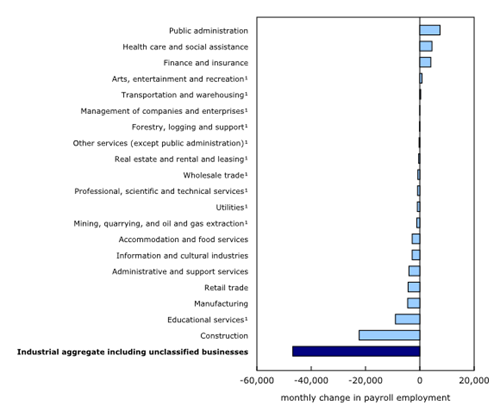Construction employment takes a big hit in August
Payroll employment across Canada took a bit hit in August, with the construction sector accounting for nearly half of the jobs lost that month.
 Data from Statistics Canada’s latest Survey of Employment, Payrolls and Hours shows employment declined by 46,800 (-0.3%) in August, following little change in July.
Data from Statistics Canada’s latest Survey of Employment, Payrolls and Hours shows employment declined by 46,800 (-0.3%) in August, following little change in July.
Construction (-22,300; -1.9%) recorded the largest payroll employment decline in August. It was the first time since March that the sector reported a payroll decline.
Overall growth in construction has slowed in 2023, following stronger gains in the second half of 2022. The sector recorded a net decline of 5,400 (-0.5%) from December 2022 to August 2023, compared with an increase of 23,800 (+2.1%) from July to December 2022.
The monthly decrease in August 2023 was concentrated in specialty trade contractors (-13,000; -1.9%), including building equipment contractors (-4,600; -1.5%) and foundation, structure and building exterior contractors (-4,000; -3.0%). Declines were also recorded in non-residential building construction (-3,900; -3.1%), heavy and civil engineering construction (-3,700; -2.0%) and residential building construction (-1,700; -1.0%).
Other sectors to report drops in payroll employment included manufacturing (-4,500; -0.3%), retail trade (-4,300; -0.2%), administrative and support, waste management and remediation services (-4,000; -0.5%), information and cultural industries (-2,800; -0.8%), and accommodation and food services (-2,800; -0.2%).
Meanwhile, job vacancies remained on a downward trend, edging down from 697,900 in July to 682,400 in August. The monthly total was the lowest reported since May 2021.
Total labour demand (which is measures as the sum of filled and vacant positions) in August 2023 was little changed compared with the beginning of the year, as job vacancies have fallen by 181,700 (-21.0%) over the period, while payroll employment has increased by 162,300 (+1.0%).
The largest monthly declines in vacancies in August were observed in manufacturing (-5,900; -11.5%), followed by information and cultural industries (-3,300; -36.7%), utilities (-1,700; -54.7%) and agriculture, forestry, fishing and hunting (-1,700; -16.8%). These decreases were partially offset by an increase in vacancies in finance and insurance (+4,400; +20.4%) and management of companies and enterprises (+700; +32.5%). The number of unfilled positions was little changed in the remaining 14 sectors.
In August, on a year-over-year basis, vacant positions were down in 17 of 20 sectors, led by retail trade (-38,800; -36.0%), accommodation and food services (-38,700; -31.4%), manufacturing (-35,700; -44.1%), and professional, scientific and technical services (-20,700; -32.9%).
The job vacancy rate—which tracks the number of vacant positions as a proportion of total labour demand—was 3.8% in August, virtually unchanged compared with July (3.9%), but down from 4.8% observed at the start of the year.
The decline since January reflects the declines in vacancies (-181,700; -21.0%) combined with gains in payroll employment (+162,300; +1.0%).








